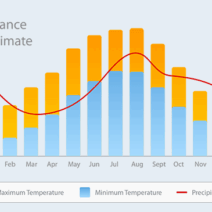Global warming, a term that encompasses the ongoing rise in average temperatures around the globe, is often linked with a series of cataclysmic environmental phenomena. However, an intriguing and relatively esoteric question arises: can global warming alter Earth’s polarity? The concept of geomagnetic polarity and its potential connection to climate change is a multidimensional topic that bridges geology, environmental science, and climatology.
To understand how global warming might correlate with the alteration of Earth’s polarity, we must first elucidate what Earth’s polarity entails. The Earth possesses a magnetic field generated by the movement of molten iron and nickel in its outer core. This magnetic field acts like a giant magnet, with magnetic north and south poles. Over geological timescales, like orbits of thousands to millions of years, the magnetic poles have reversed, a phenomenon known as geomagnetic reversal. These reversals are unpredictable and occur at irregular intervals, typically ranging from hundreds of thousands to millions of years apart.
The scientific community largely agrees that the relationship between climate change and geomagnetic reversals is obscure. Climate change, particularly the anthropogenic kind that is accelerating due to human activities, is a contemporary issue closely tied to atmospheric, oceanographic, and ecological systems. The immediate effects of global warming—such as melting ice caps, rising sea levels, and extreme weather events—dominate discussions on climate change. However, the ability of global warming to invoke changes in Earth’s magnetic field is a much more contentious area of research.
Research has indicated that the mechanisms behind geomagnetic reversals are complex and primarily driven by dynamical processes within the Earth’s outer core. It involves fluid dynamics and the magnetic induction processes that cannot be directly influenced by surface atmospheric changes. However, the thought that increased temperatures and consequent environmental stress might have an indirect impact on geological processes is worth exploring.
One potential avenue of influence hinges on the notion of mantle convection. This refers to the slow creep of the Earth’s mantle caused by the heat from the core. Increased surface temperatures could theoretically lead to alterations in the mantle’s thermal regime. If mantle convection patterns change significantly, they might affect the liquid outer core’s flow dynamics, potentially influencing the magnetic field generation. However, this is still speculative and would require further rigorous investigation.
Moreover, while short-term climatic changes primarily affect surface phenomena, long-term geological phenomena dictate the state of the Earth’s interior. Scientific evidence, such as the record preserved in igneous rocks and ocean sediment cores, showcases a tenuous correlation between climatic events and magnetic reversals over geological time. For instance, certain magnetic reversals have coincided with periods of intense volcanic activity, which themselves can be linked to climate changes due to tectonic movements. However, differentiating between causation and correlation is a hazardous endeavor in this context.
The geomagnetic field acts as a shield, protecting life on Earth from harmful solar radiation and cosmic rays. A shift in this polarity, while primarily a geological phenomenon, could have subtle implications for Earth’s surface environment, particularly if it were to occur rapidly or in an unprecedented manner. Some researchers postulate that during a geomagnetic event, the weakening of the magnetic field could allow increased radiation to penetrate the atmosphere. This could potentially lead to heightened levels of atmospheric ionization, affecting climatic conditions and, by extension, biological systems.
Nevertheless, such scenarios remain largely theoretical and anecdotal. The geological record shows that geomagnetic reversals tend to occur over thousands of years, allowing ample time for ecological systems to adapt. This gradual pace seems improbable to present-day anthropogenic climate changes, which are unfolding with alarming rapidity. The fear, then, is less about a potential reversal of magnetic polarity spurred by global warming and more about the immediate and dire consequences of climate disruption.
In discussing public interest, it is crucial to highlight that while the alteration of Earth’s polarity remains an abstract conjecture under the influence of environmental changes, the ramifications of global warming are immediate, tangible, and irreversible. Rising temperatures are leading to the loss of biodiversity, habitat destruction, and pervasive alterations in weather patterns that jeopardize food security and human health. By focusing on these pressing issues, the conversation can remain anchored in scientific rigor while promoting urgency in addressing climate change.
In conclusion, the hypothesis that global warming may alter Earth’s polarity engages a complex interplay of geological and climatological processes. Although there is no direct evidence to assert that anthropogenic climate change can influence geomagnetic reversals, the interconnectedness of Earth’s systems invites continued inquiry. Scholars advocate for sustained interdisciplinary research to inch closer to reliable predictions regarding the coalescence of geomagnetic and climatological phenomena. Importantly, awareness and stewardship of climate change remain crucial, directing attention towards the immediate battle against environmental degradation. It becomes clear that prioritizing an understanding of climate science is imperative for the sustainability of ecosystems and, ultimately, civilization itself.






